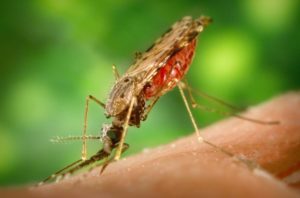„The mosquito anopheles has been described as the most dangereous insect in the world. It is no wonder, estimates vary, some suggesting that 2 million people die from malaria each year…
How malaria is transmitted
The female mosquito lands on the skin and inserts its mouth parts until it finds a blood vessel. The wall of the blood vessel is damaged, blood pours out, and the mosquito prevents this blood from clotting by injecting, from its saliva, an anti-coagulant. The blood provides an excellent meal, it is concentradet protein which supports their production of eggs…. If an anopheles mosquito feeds on someone infected with malaria parasites, it takes them into own body, and then when it feeds again it injects the parasites into another human being. Once inside the human body they spend a week in the liver, and then enter red blood cells and join the bloodstream. The parasites are protozoa; inside the human body they mutate and destroy red bllod cells. Thus they are capable of causing horrendus problems in internal organs, heart failure, suffocation of the brain or coma.
Fighting malaria
First idea: destroy the breeding ground of the mosquitoes. Mosquito larvae live underwater, so marshes were drained, slow moving rivers were cleared and oil was spread on the surface of the water. Even bombs were used to destroy the larvae and their habitat. As a result of these methods, Mussolini was able to announce, in the 1930s that, for the first time in history, the area areound Rme was free of malaria.
Second idea: kill the mosquitoes with insecticide. Whenever American troops had been involved in a military compaign in an area where malaria was present, during the Second World War the American military devoted huge financial resources to research into possible insecticides. They discovered a cheap compound that was so deadly, that even the tiniest quantities completely destroyed the nervous system of mosquitoes. It was the famous DDT. Using DDT, the World Health Organisations aimed to destroy all mosquitoes and therefore eradicate malaria throughout the entire world by the 1990s. The programme met with considerable success; malaria was eradicated from Europe, North America and Russia, and dramatically reduced in South America, India and Sri Lanka. Mosquitoes are, however, remarkably resilient insects, they began to develop a resistence to DDT… New insecticides were developed, but these were much more expensive. The aim of eradicating malaria world-wide was abandoned. In Florida, USA, mosquitoes are successfully kept under control, but with an annual budget of $300 milion. Virtually no other country could afford that sort of money.” (ANAMED)
Third idea: kill the parasite. The malaria parasite evades the normal immune systems in our bodies bacause it lives inside the red blood cells. Scientists were, therefore, unable to develop a vaccine, so they began to conduct research into possible drugs. It had been long known that quinine, witch came from the South American cinchona tree, taken in large quantities over a long period of time, was very effective in killing malaria parasites, but had many side effects. Gradually, cheaper and safer drugs weredeveloped, the best known of which was chloroquine. This saved millions of lives. In the cool comfort of the insect’s body, however, the protozoa reproduce, and, as they multiply, they constantly create new mutations, each genetically different from the other.
Consequently, as soon as nw drug was developed, the parasite learned how to become resistant to that drug.
In 1967 Chairman Mao launched a new initiative to solve the problem of malaria. Because everything in the West was considering decadent, including medicine, scientists looked to thier own herbs which had played a key role in ancient Chinese medicine. Eventually they found a 2,000 year old recipe for a tea made from Artemisia annua that claimed to cure malaria. They distilled the tea, and by chemical means isolated the active ingredient artemisinin. The subsequent drug they produced was remarkable, it cleared the blood of malaria parasites quicker than any drud in history! The Chinese claimed that the molecule of the drug was completly different from any other anti-malarial; it contained an endo-peroxide wich, unusually in the history of medical research, was stable. ANAMED
Many western scientifist were sceptical, and did not understand how is succeeded in killing the parasites. Further, at that time, relations between China and the West were very poor, and the Chinese were not willing to share the results of their research with the West. The result was that many years were lost before the Americans found their own source Artemisia annua plants and commenced their own urgent research programme! Thus it was the mid nineties before artemisia based drugs became available.


